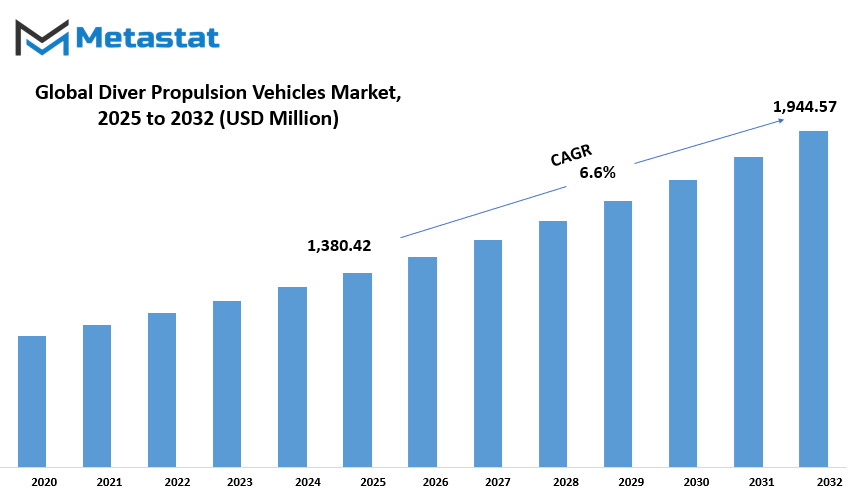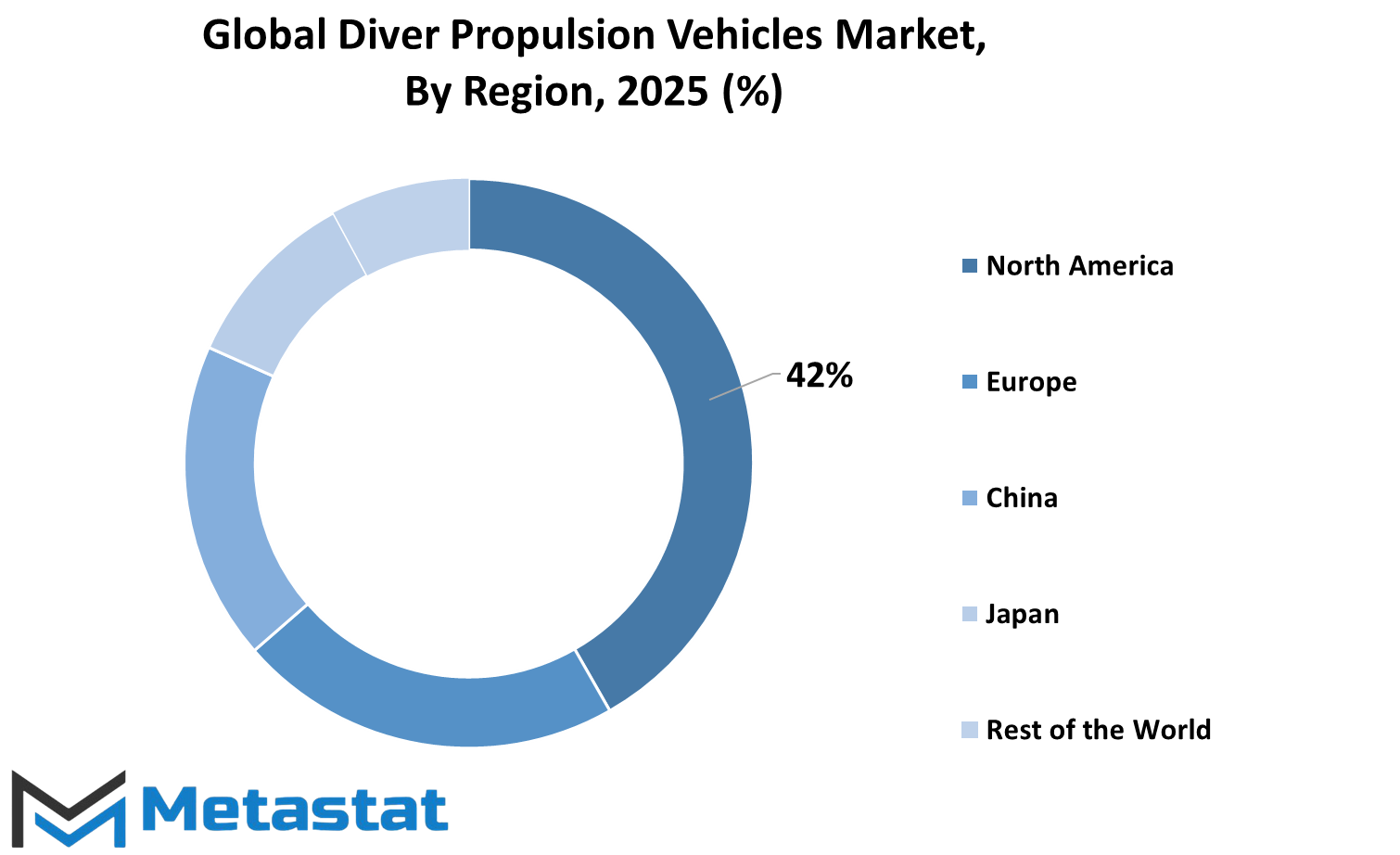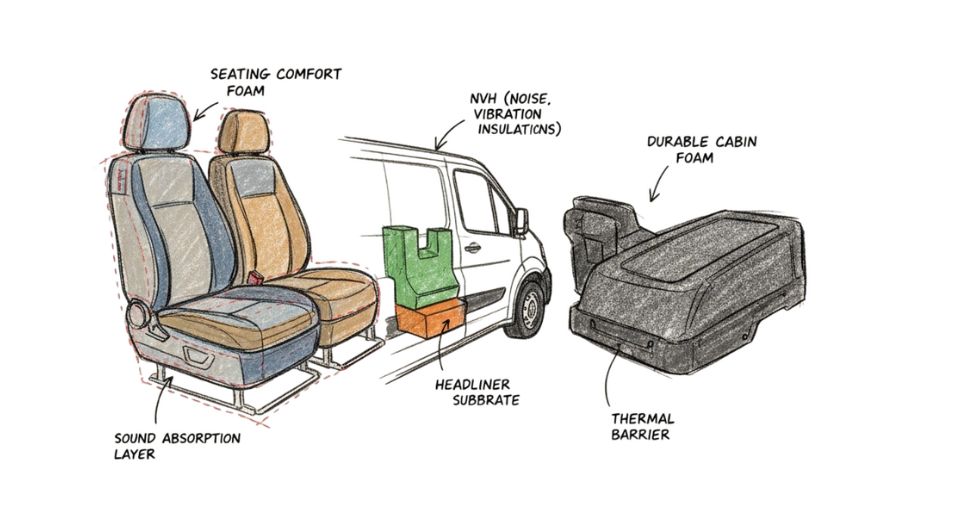MARKET OVERVIEW
The Global Diver Propulsion Vehicles market will be navigating a landscape that is becoming more complex with evolving military, commercial, and recreational demands for underwater mobility. On one hand, military scenarios will influence the operational changes in the industry, while on the other, they will prioritize the needs of different applications as the market evolves: propellant markets will have to cope with the much wider definition of DPVs based on their use.
They will no longer simply be thought of as a means of transport for divers but rather as the integration of DPV technology for ever-growing underwater tasks capable of performing works once regarded as secondary. In the military context, DPVs will allow for better surveillance and stealthy movement, eclipsing any notion of them as mere mobility tools. This transformation will be taken to the civil and research areas, where the focus will now shift toward data collection and ecosystem access rather than speed or distance. Soon, DPVs will be seen by organizations and agencies as necessity tools as opposed to merely desirable ones.
Undersea logistics is one aspect in which the Global Diver Propulsion Vehicles market will push the envelope. Being allowed to carry lightweight cargo or to help carry technical diving equipment will provide new avenues of function. These explorations by scientists will no longer be inhibited by limited diver endurance or difficult terrain but rather will be enabled by vehicles adequately designed for environmental mapping or biological monitoring. Think precision, think adaptability: these are values that will showcase the DPVs' role on missions far beyond that of diver support.
With investments in deep-sea infrastructures, DPVs will assist in the inspection, maintenance, and emergency response. They will also act as relay nodes or scouting units, thanks to their compatibility with advanced sensor systems and communication protocols. This capability will be of paramount importance in offshore energy fields and maintenance of submarine cables, where access is often fraught with difficulty and time pressure. DPVs will become mission-critical assets rather than auxiliary ones.
The recreational segment will also undergo transformations, with divers in pursuit of caves, wrecks, and deep-water locations expecting far more from their vehicles than propulsion—navigation support, built-in lights and fail-safe controls will become non-negotiable hopes. The market, in responding to these changes, must emphasize design intelligence and user-centered features rather than focus on standardization and modular customization.
The Global Diver Propulsion Vehicles market will also enable the shaping of partnerships across technology and marine research sectors. The collaborative focus encompassing machine learning, underwater imaging, and real-time environmental analysis will place DPVs at the center of innovation.
Global Diver Propulsion Vehicles market is estimated to reach $1,944.57 Million by 2032; growing at a CAGR of 6.6% from 2025 to 2032.

GROWTH FACTORS
The global Diver Propulsion Vehicles market is growing significantly, fueled primarily by the increasing engagement of diving enthusiasts in recreational diving and underwater explorations. The greatest mobility in and for longer durations has increased the demand for DPVs amongst divers. DPVs provide divers with the facility of easy movement through water, thereby covering larger areas for exploration with less fatigue. This surge in demand is not only seen within recreation but also, to a larger extent, in industries and professional divers that utilize underwater exploration.
With increased demand, some of the advancements in technology made in some of the DPVs have become a driver for the DPV segment. Better battery life, propulsion systems, and ergonomics have together made lighter, more efficient, more user-friendly versions. These developments made DPVs more exciting to an increasingly broad consumer base, including some who may previously have regarded them as too technical or costly to use. With each new development technology has decreased mass while improving energy efficiency and comfort on long underwater tours. Continuing product innovations keep this market buzzing among veteran divers and newcomers alike.
However, while the future for DPVs looks bright, some constraints impede the growth of the market. High DPV purchase costs plus recurring expenses for accessories and maintenance render such products inaccessible to the casual diver, especially those on a limited budget. Such costs may deter some from ever thinking of DPVs, especially those who will occasionally dive. Furthermore, certain diving sites and conservation areas impose regulatory restrictions and safety concerns that limit the use of DPVs. Environmental policies in some areas may likewise restrain their usage, limiting access to protected underwater zones.
Contrary to such restrictions, the opportunities for DPV growth should still abound. The emergence of new markets, especially among new demographics, creates exciting opportunities. Adventure tourism, scientific research, and underwater film production are all potential significant diversifications for the market. Demand for specialized DPVs to meet customized needs will thereby increase as interest waxes and wanes. Henceforth, these developments could foster a continued upward trend in the growth and expansion of DPVs as an essential tool for recreational and professionally inclined underwater exploration.
MARKET SEGMENTATION
By Type
Diver Propulsion Vehicles (DPVs) have considerable potential for growth and innovation. Primarily, these vehicles are meant to enhance the mobility of divers underwater for longer-distance travel with less effort. Other problems divers face, like limited air supply or physical exertion, are resolved as DPVs let a diver conserve energy to concentrate on work or exploration. This then leads to an increase in demand within this market segment for DPVs and corresponding types of it to cater to the different needs of consumers.
The market has segmented the types of Diver Propulsion Vehicle, with one of the most significant segments being Sit-on DPVs, which, with a $475.4 million valuation, represents the most significant share. These are vehicles whereby a user can sit on top of the device, allowing him or her easy steering and control of the vehicle while submerged. This design is demanded by recreational divers and those looking to explore shallow waters or large marine ecosystems.
Another segment is Tow-behind DPVs. As the name suggests, these vehicles are towed behind the diver, making for an even more streamlined solution minimizing physical exertion. Commercial divers or professionals who need to travel long distances underwater do employ tow-behind DPVs, just as do those in research and underwater photography. These vehicles generally find favor due to their practical design and energy conservation possibilities for the diver.
Manned Torpedoes also form a significant part of the market for DPVs. These are usually designed for one or more people in the military, commercial, and recreational fields. The U-shaped design allows for faster speeds and better maneuverability in the water and is hence used for higher demanding jobs or longer explorations. Manned Torpedoes are generally used by people in need of higher performance-type applications like special operations units and advanced recreational divers.
Last but not least, the 'Others' feature a variety of lesser-known types of DPVs geared towards special applications. These may include custom-built, or niche products designed for specific underwater tasks or environments. Although this segment may not have a massive market share in terms of total sales, it fills the important role of catering to specific user needs.
To conclude, the DPVs market is diverse, having various types of vehicles satisfying both generalized and specialized needs. The different segments, such as Sit-on DPVs, Tow-behind models, Manned Torpedoes, and others, indicate that these vehicles are not solely for recreation, as they find important applications in commercial, military, and research activities. The further advancement, innovation, and increase in demand for underwater mobility are to be awaited in future as the market grows.
By Run Time
The Global Diver Propulsion Vehicles (DPV) market is segmented in runtime into three major classes: below 60 minutes, 60-200 minutes, and above 200 minutes, thus allowing for some understanding of the different requirements of the divers based on the duration of the underwater exploration. Each of the segments is aimed at a different requirement, and the choice of DPV is preeminently influenced by the expectation of time the diver is to remain underwater.
Generally, the Below 60 Minutes category encompasses smaller and more compact DPVs. They are mainly used for short recreational dives or in situations where the diver requires transportation for relatively short distances. The design of the vehicles-offering good battery life to support short excursion underwater-was, therefore, oriented towards flexibility and easy handling. Likewise, a diver within this runtime category may utilize such vehicles in shallow water for quick inspection or exploration.
Conversely, the 60-200 minutes segment is for those who need a greater range with a performance increase. These DPVs typically have greater power and can carry bigger batteries that allow divers to go deep or far away. Divers from both recreational and professional backgrounds use this category, with the latter engaging in underwater activity that warrants time on the DPV. The extra run time ensures that divers have enough juice for other activities, such as photography, wreck diving, or research. The design of such vehicles balances power, portability, and runtime, making them popular among many divers.
The Above 200 Minutes segment is oriented toward high-end, professional-grade DPVs. These vehicles are best for anyone needing maximum endurance like deep-sea exploration, research, or military operations. This DPV allows the diver to travel far distances and stay submerged for a long time using advanced battery technology and larger motors. These DPVs can remain in the water for hours without resurfacing; consequently, they are mostly used for serious underwater activities.
Consequently, in short, the Global DPV market is determined by the specific demands of some divers, with the runtime being among the crucial factors for choosing a relevant vehicle. Whether for short recreational dives, long professional assignments, or deep-sea explorations, the market is intended to provide several possibilities to meet those varying needs. Each of the segments offers the necessary technologies for divers to execute their profession depending on the duration of underwater activities for efficiency and safety in several underwater environments.
By Application
The Global Diver Propulsion Vehicles Market is growing as these vehicles are being popularized across many sectors. It helps the diver navigate underwater more efficiently with less physical effort, increasing the time of exploration. The growing versatility of the growing DPV market is the reason for its increasing demand from various sectors, like tourism, military, professional diving, and diving training.
Diving tourists have started adding DPVs as an important element in enhancing their diving experience. Scuba tourists will be able to explore greater sections of the underwater environment much more easily. The experience is further enhanced when diver exploration is done with the use of DPVs, which enables the diver to cover more ground. The increased interest in underwater tourism certainly is one of the major drivers of their demand.
The military has a major portion of the DPV market. The tactical operations by military divers include reconnaissance, combat, and other specific missions, for which they require the use of DPVs. These vehicles offer a good solution for reconnaissance and specialized underwater operations as they provide an efficient underwater navigation technique for most military personnel, especially in covert operations or during military missions that require speed and precision. The defence budget allocations will likely continue to grow because of the ongoing advanced technological need in military operations.
All in all, DPVs play a major role in more efficient work and safety for professional divers. They are required by professional divers engaged in underwater construction, maintenance, and research to finish their work as fast and efficiently as possible. DPVs save energy, allow longer dives, and have enabled detailed work by divers. The growing number of professional divers is another source contributing to the market's growth.
The market for DPVs is also driven by the aspect of diving training. The training agencies have employed the DPV as a learning tool to prepare divers to be able to work with propulsion systems. Additionally, it is a safe and controlled method that allows a diver to gain experience using different underwater settings. Increasing diving training programs will create an even greater need for DPVs in the future.
DPVs also have a long list of other uses in other industries like research, exploration, and environmental monitoring, where they are of great importance in performing some specific tasks underwater. Demand will continue growing through these and other applications in industries that realize the potential of DPVs.
Clearly, the Global DPV market is growing, as noted, through increased usage in tourism, military, professional diving, many types of training, and many other areas that all benefit from the advanced capabilities these vehicles offer.
|
Forecast Period |
2025-2032 |
|
Market Size in 2025 |
$1,380.42 million |
|
Market Size by 2032 |
$1,944.57 Million |
|
Growth Rate from 2025 to 2032 |
6.6% |
|
Base Year |
2024 |
|
Regions Covered |
North America, Europe, Asia-Pacific, South America, Middle East & Africa |
REGIONAL ANALYSIS
North America, Europe, Asia Pacific, South America and Middle East and Africa are the significant segments of Diver Propulsion Vehicles (DPVs) regional markets. In North America, for example, nations are grouped into such states like U.S., Canada, and Mexico. Europe; comprises major countries like the UK, Germany, France, and Italy, and the rest of Europe.
Asia-Pacific has also been important, and some countries such as India, China, Japan, and South Korea are leading in adopting Diver Propulsion Vehicles. The other momentum-driving factors are the projections of growth in marine exploration, tourism, and recreational diving activities in the area. South America is also included with Brazil and Argentina mainly capturing the demand, but together with the other countries in South America.
The Middle East & Africa is there segmented into further divisions like GCC countries, Egypt, South Africa and other Middle East and African regions. Increasing industries such as tourism, marine exploration and the interest in recreational underwater activities are contributing factors in boosting the demand for Diver Propulsion Vehicles in the region.
Since these markets are going to continue expanding and developing, the market for Diver Propulsion Vehicles will gradually increase. As such, it will encourage a growing interest in underwater exploration, tourism, and recreational diving, all of which will increase demand for advanced and efficient DPVs in both developed and emerging markets.

COMPETITIVE PLAYERS
The currency in the Global Diver Propulsion Vehicle (DPV) market is fast changing with various companies leading in innovation and competition. Few among the key players of this industry are the well-established names that include Dive Xtras; The Submarine Exploration Company (Suex); STIDD Systems, Inc.; SEA-DOO; Torpedo Inc.; Apollo Military; Pegasus Manufacturing Inc.; CAYAGO AG (Seabob); Bonex GmbH & CO.KG; SCUBAJET GmbH; ROTINOR GmbH; Seacraft; Sublue; Waydoo and Yamaha. These are the firms vigorously working at developing advanced propulsion technology that meets the demands of divers working in the underwater environment.
The ever-increasing number of recreational and professional divers around the world has in turn increased demand for diver propulsion vehicles. DPVs give divers a better underwater travel alternative, resulting in the improvement of their exploration and safety. These vehicles find application in recreational diving, underwater photography, research missions, and military operations. In various situations, they become crucial tools since they reduce diver fatigue, prolong dive times, and increase area coverage.
The DPV manufacturing company offers innovations with each unit it releases. Dive Xtras is well known for streamlining and ruggedness, while Suex specializes in high-performance DPVs with unique features targeting technical divers. Basically, CAYAGO AG (Seabob) and Bonex GmbH & CO.KG concentrate on blending lifting performance and intuitive handling, catering to professional and recreational divers alike.
The latest trends on the market further encourage making DPVs more affordable and easier to use with lightweight, improved battery life, and advanced safety features. Innovation in battery technologies and motor efficiency will be most important since they directly influence vehicle performance and endurance underwater.
The DPV market has been propelled by various key factors such as increased exposure to diving as a hobby, continuous improvements in technology, and the emerging need for fast underwater transportation. Furthermore, the demand for a high-performance and reliable DPV is expected to continue to rise with the onset of underwater tourism. The presence of bigger players like Yamaha also complements the market, as these big brands instill some trust and reliability into consumers.
Thus, the Diver Propulsion Vehicle market has significantly developed thanks to the contributions of the front-line players. Great progress, even of larger magnitude, is expected within the industry as innovation continues to roll out as a direct benefit to both professional and recreational divers.
Diver Propulsion Vehicles Market Key Segments:
By Type
- Sit-on
- Tow-behind
- Manned Torpedoes
- Other
By Run Time
- Below 60 Minutes
- 60-200 Minutes
- Above 200 Minutes
By Application
- Tourism
- Military
- Profession Divers
- Diving Training
- Other
Key Global Diver Propulsion Vehicles Industry Players
- Dive Xtras
- The Submarine Exploration Company (Suex)
- STIDD Systems, Inc.
- SEA-DOO
- Torpedo Inc.
- Apollo Military.
- Pegasus Manufacturing Inc
- CAYAGO AG (Seabob)
- Bonex GmbH & CO.KG
- SCUBAJET GmbH
- ROTINOR GmbH
- Seacraft
- Sublue
- Waydoo
- Yamaha
WHAT REPORT PROVIDES
- Full in-depth analysis of the parent Industry
- Important changes in market and its dynamics
- Segmentation details of the market
- Former, on-going, and projected market analysis in terms of volume and value
- Assessment of niche industry developments
- Market share analysis
- Key strategies of major players
- Emerging segments and regional growth potential











 US: +1 3023308252
US: +1 3023308252






